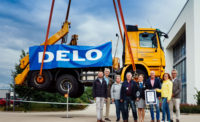The notion that a truly special moment comes along just once in a decade is not popular among members of the Academic Motorsports Club Zurich (AMCZ). Founded by students at the Swiss Federal Institute of Technology Zurich (ETH Zurich) in 2006, the club has a long list of achievements in its brief 10-year history.
For starters, it has produced a prototype vehicle to compete in various Formula Student or SAE (FS) competitions in Europe every year. Also, AMCZ was the first Swiss team to enter FS competitions, and it has been ranked No. 1 in the world the past three years. Most importantly, the club broke the Guinness world record for the fastest acceleration from 0 to 100 kph by an electric car last June 22.
Known as grimsel, the car set the record (1.513 seconds) on a 120-meter track at Dübendorf aerodrome in Switzerland on its first attempt. Grimsel is made mostly of carbon fiber and weighs just 168 kilograms. It features four specially developed wheel hub motors capable of generating 200 horsepower and 1,700 newton-meters of torque. An onboard computer applies traction control to regulate the performance of each wheel and optimize acceleration.
The car reached its record speed after traveling only 30 meters, easily eclipsing the old mark of 1.779 seconds set by a student racing team from Stuttgart, Germany, in 2015. Not only that, the vehicle is 0.5-second faster than the world’s fastest production cars, including the Tesla (in Ludicrous Speed mode), the Bugatti and the Porsche Hypercar.
Made up from students from ETH Zurich and the Lucerne University of Applied Sciences and Arts, AMCZ built three cars powered by combustion engines from 2006 to 2009, before switching to electric vehicles in 2010. The club has many sponsors, including institutes of various Swiss universities, and numerous manufacturers and suppliers.
Kistler Group, for example, has sponsored the club the past four years, and its optical Correvit SFII sensor recorded the record-breaking time. Jonas Abeken, vice president of AMCZ, says the club selected the noncontact sensor for the world record attempt because it provides time measurement data down to thousandths of a second.
Miniature and lightweight, the SFII mounts below the racing vehicle near its center of gravity. Four analog and four digital outputs permit simultaneous measurement of longitudinal, transversal and magnitude speed (0.3 to 250 kilometers per hour), as well as angle measurement (±40 degrees).
The sensor has a measurement accuracy of ±0.5 percent (full scale output), even under harsh environmental conditions. A protective glass lens prevents damage to the optics and the illumination source, and is easily replaced without special tools.
The sensor can be used with any current data acquisition system, and it transmits data via CAN Bus, RS-232C or USB adapter. For more information on optical sensors, call 248-668-6900 or visit www.kistler.com.






